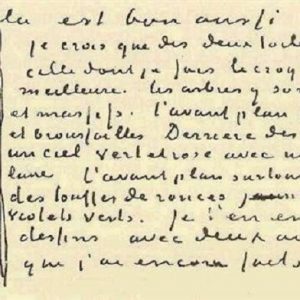In the realm of art history, few artists have captured the public imagination quite like Vincent van Gogh. Known for his vibrant, emotionally charged paintings, Van Gogh’s work often offers a glimpse into his tumultuous inner world. One of his lesser-known but equally compelling works is the small oil painting “Skull of a Skeleton with Burning Cigarette,” a haunting memento mori that showcases Van Gogh’s early artistic development and his penchant for dark, satirical themes.
Painted likely during the winter of 1885-1886, while Van Gogh was studying at the Royal Academy of Fine Arts in Antwerp, Belgium, “Skull of a Skeleton with Burning Cigarette” is a striking departure from the colorful, Post-Impressionist style he would later become famous for. The small canvas, measuring just 32 by 24.5 centimeters, features a stark, almost monochromatic palette, with the skull and cigarette rendered in shades of white, gray, and black against a dark background.
At first glance, the painting might appear to be a straightforward still life, but closer inspection reveals a deeper, more complex meaning. The skull, a classic vanitas symbol, serves as a reminder of the fleeting nature of life and the inevitability of death. The burning cigarette, placed jauntily between the skull’s teeth, adds an element of dark humor to the composition, as if the skeleton itself is taking a final drag before crumbling into dust.
But the cigarette also serves another purpose: it’s a biting commentary on the academic art practices of the time. In the 19th century, before live models were commonly used, art students were often required to study and draw skeletons to gain a better understanding of human anatomy. Van Gogh, who found his classes at the Royal Academy boring and uninspiring, likely painted “Skull of a Skeleton with Burning Cigarette” as a satirical take on this tradition, injecting a bit of macabre wit into an otherwise dry subject matter.
The painting also offers insight into Van Gogh’s state of mind during this period. In poor health and struggling to find his artistic voice, Van Gogh may have identified with the skull, seeing it as a reflection of his own mortality and the challenges he faced. The cigarette, too, takes on a personal meaning, as Van Gogh was a heavy smoker throughout his life, a habit he maintained until his untimely death in 1890.
Despite its small size and simple composition, “Skull of a Skeleton with Burning Cigarette” packs a powerful visual and emotional punch. The juxtaposition of the stark, lifeless skull with the glowing, ember-like cigarette creates a sense of tension and unease, inviting the viewer to contemplate their own mortality and the fleeting nature of existence.
Interestingly, while the painting is often interpreted as a criticism of smoking, Van Gogh himself was an avid smoker, and it’s unlikely that he intended the work to be a commentary on the dangers of tobacco. Instead, the cigarette serves as a symbol of life’s ephemeral pleasures, a small comfort in the face of death’s inevitable approach.
Aesthetically, the painting bears the influence of several other artists, including the 17th-century Dutch painter Hercules Segers and Van Gogh’s Belgian contemporary Félicien Rops, both of whom were known for their dark, often macabre subject matter. However, Van Gogh’s unique style and vision shine through, hinting at the bold, expressive brushwork that would later define his most famous works.
“Skull of a Skeleton with Burning Cigarette” is a testament to Van Gogh’s enduring legacy and his ability to imbue even the most unsettling subjects with a sense of humanity and emotional depth. Though often overshadowed by his more colorful, Post-Impressionist works, this small painting offers a rare glimpse into Van Gogh’s early artistic development and his lifelong fascination with the mysteries of life and death.
Today, the painting resides in the permanent collection of the Van Gogh Museum in Amsterdam, where it serves as a haunting reminder of the artist’s singular vision and his enduring impact on the world of art. Whether viewed as a satirical comment on academic traditions, a personal reflection on mortality, or simply a masterful study in light and shadow, “Skull of a Skeleton with Burning Cigarette” continues to captivate and inspire viewers, inviting us to contemplate the profound questions of life, death, and the enduring power of art.














